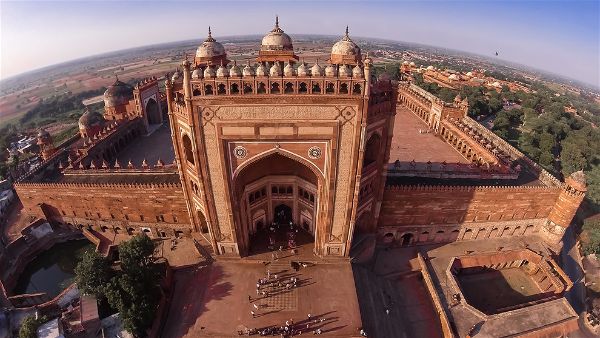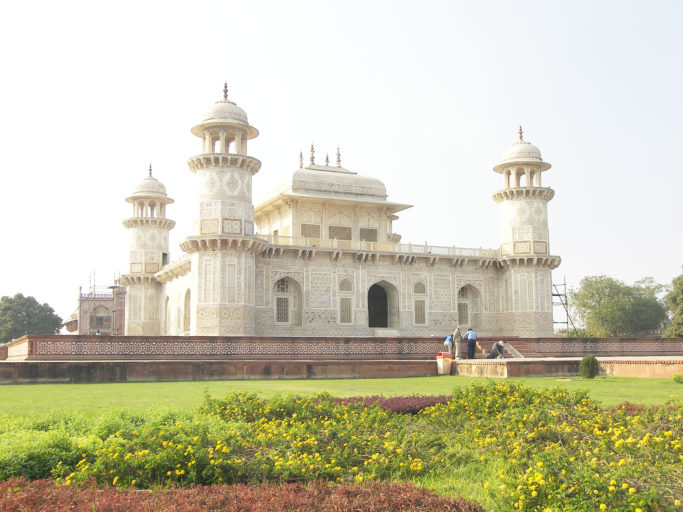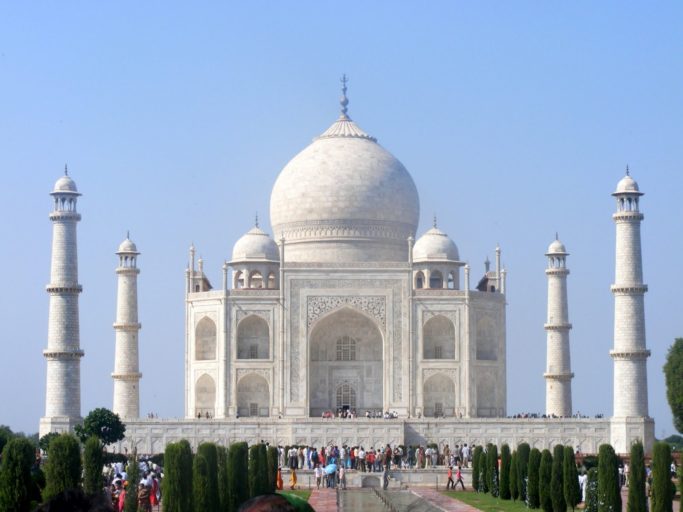Orchha is a town in Madhya Pradesh near the banks of Betwa river. The medieval city of Orchha seems to have frozen in time, its palaces and temples still retaining their original grandeur. Orchha had the distinction of being the capital of one of the largest and most powerful kingdoms of Central India. The Bundela Rajput chieftain, Rudra Pratap, founded the city, located by the side of the beautiful Betwa River, in the 16th century. The word Orchha means ‘hidden’. When the Tughlaqs, who were ruling Delhi in the 15th century, pushed the Bundelkhand rajas out of Garkhundar, they retreated to distant Orchha.
Orchha travel offers detailed information on the important tourist destinations, dinning and accommodation facilities and means of transportation of the town. Orchha is a small town in the Tikamgarh district of Madhya Pradesh, which is situated at a distance of 120 kilometers from Gwalior and 178 kilometers from Khajuraho. The best time to visit Orchha is between October and March.
Orchha was founded in 16th century by Rudra Pratap, a Bundela chieftain. The rich historical legacy of the town is preserved in the beautiful stone sculptors and the ancient forts and buildings of the town. The travel to Orchha provides the tourists with an opportunity to explore the rich cultural heritage of the town. One must tour Orchha to discover the rich architectural splendor of the town.
A travel to Orchha would take you to a scenic destination where austere hills rise in striking contrast with the lush green surrounding along the limpid flowing river Betwa. Tourist attractions in Orchha still retain much of their pristine charm.
Orcha Fort
Orchha, situated on river Betwa, has various historical legends associated with it. However, not much of it is known before the 1501 A.D. when the city was founded by Rudra Pratap sinhg, a Rajput ruler of Bundelkhand. He was the first king of Orchha and built the Orchha Fort.
The city was attacked by the Mughal Army under the generalship of Shah Jahan, in the early part of the 17th century. The Mughals gained reign over the city and ruled here till 1641 A.D. All the attempts of the Marathas to rule over Orchha went in vain and in the year 1783, Tehri was declared as the capital of Orchha.
The city was ruled by Hamir Singh from 1848 to 1874 A.D and in the year 1865, the king gained the title of the ‘Maharaja’. Maharaja Pratap Singh sat on the throne of Orchha in 1874.
Orchha was declared as a part of Madhya Pradesh in the year 1956.
Ram Raja Orcha
Madhukar Shah Ju Dev (1554-1592) was a devotee of Banke Bihari (Lord Krishna) while his wife Queen Ganesh Kunwari was a devotee of LordRam.One day the King and the Queen went to Lord Krishna’s temple but the temple had closed by that time. The queen urged the king to go back but the king wanted to stay. So both the king and queen decided to stay back. They joined a group of devotees who were singing and dancing in praise of Lord Krishna outside the temple and started singing and dancing. It is believed that Lord Krishna and Radha personified and danced with them and golden flowers were showered on them.
After this the king asked the queen to accompany him to Mathura but the queen wanted to go to Ayodhya. The queen was adamant at which the king said that “You keep praying to Ram but Ram never appears in front of us. If you want to go to Ayodhya then go, but return only when you have the child form of Ram with you.” The queen left the palace and started the journey to Ayodhya. She ordered her servants to start building a temple (Chaturbhuj Temple) for Lord Ram.
On reaching Ayodhya, the Queen started praying to Lord Ram. The Queen fasted and prayed for about a month but Lord Ram did not appeared. So she jumped into the river. Just then Lord Ram appeared in child form in the Queen’s lap. Lord Ram told the queen that she could ask for a boon, at which the queen asked Ram to come with her in child form to Orchha. Ram agreed to go but he put forth three conditions: “I will travel only in Pukh Nakshatra. When Pukh Nakshatra will end I will stop and resume only when Pukh Nakshatra sets in again. Secondly, once I reach Orchha, I will be the King of Orchha and Thirdly, the first place you seat me will be my final place.” The Queen agreed and started her journey. It took 8 months and 27 days for the queen to reach Orchha from Ayodhya on foot (between 1574 to 1575).
King Madhukar Shah meanwhile had a dream where Lord Banke Bihari scolded him on discriminating between Lord Ram and himself. King was very apologetic. When he woke up he found out that the queen was returning from Ayodhya. King apologized to the queen but she did not accept king’s apology. On returning to Orchha, the queen went back to her palace with baby Ram but Lord Ram transformed into an idol and got transfixed in the queen’s palace itself.
To this day the Ram Raja Temple is in the queen’s palace and not in the Chaturbhuj Temple .Additionally, as promised by the queen, Lord Ram is the King of Orchha, hence the name Ram Raja Temple
Jehangir Palace Orch
Orchha is an emerald of Madhya Pradesh, and has a proud to be the city of Rajputs. The town situated Northern part of Central Indian in Madhya Pradesh state. Rudra Pratap Singh was a Bundela Ruler who initiated the construction of Orchha, during the medieval times of 16th century, but couldn’t complete it as he had been killed while saving a cow from the clutches of a Tiger. As Rudra Pratap has no child so his younger brother Bharti Chand became king and continued the work. After Bharti Chand next king was his son Ram Shah (1592-1605). But turn around took place when Bir Singh Dev was declared as Maharaja of Orchha by Mughal Emperor Jahangir as he helped Jahangir during his revolt against Akbar. Just to give thanks to Jahangir, Bir Singh ordered to construct Jahangir Palace and later invited Jahangir to visit Orchha and stay here. The most dashing Bundela Ruler Bir Singh Deo built around 52 forts and other things across the region during his 22 years of odd age, in them famous were citadel of Jhansi, the rembling Narsingh Dev at Datia, apart from Sheesh Mahal, which is now converted into a Heritage Hotel.
ARCHITECTURE
This palace was built by Raja Bir Singh Deo-1 in between years 1605 to 1626. It was made in honor of Mughal emperor Jahangir. During that time Bundela rulers of Orchha maintains good relationship with Mughals. Here entire palace is constructed around a square shaped courtyard with side of 67.6 meter each. It is a three storied palace built mainly with red and yellow sandstone and have 136 rooms decorated with wall paintings. Being constructed to resemble the good relationship of Bundelas (Hindus) with Mughals (Muslims) here we can identify the confluence of both Hindu and Islamic architectures like in domes, rooms, entrance gates, terraces, corridors. It is a percy-brown monuments covering a square of 220 feet side and rising into an immense rectangular mass supporting 8 graceful domes. It encompasses all qualities that is expected in a medieval castle. Palace is built on the bank of Betwa river with surrounding of green forest offering picturesque and romantic surrounding view. Presence of elephant images and painting inside rooms gives a touch of hindu architecture in building. Behing palace their is a camel stable. Although whole building isdedicated to Jahangir and Raja Bir Singh Deo friendship but when Jahangir came here, he stayed here for just one night.
TOURISM
Jahangir palace is just adjacent to Raj Mahal of Orchha. It is a Betwa river facing palace covering about 220 square feet area. It is now maintained by Madhya Pradesh Archeology department. Raj Mahal and Jahangir palace are main tourist attractions for visitors. It is open for visitors from sunrise to sunset. Tourists are required to take entrance ticket from ticket counter their before visiting this historical monument. Guides are available their in the service of visitor but it is not mandatory for visitor to take their service. Here we can get guides of different languages like Hindi, English, French, Spanish etc. Ticket taken from counter is not just limited for Raj Mahal and Jahangir Palace but can be used as entrance pass for visiting other nearby monuments like cenotaphs, temples etc. Usually it takes about one hour or more to completely visit the palace. Photography is allowed inside the palace. While visiting the Jahangir palace, one can notice the presence of vultures mostly on palace domes as inviting visitors to shoot them. If you want to see the palace in night under artificial light system, you can attend light & sound show just similar to Khajuraho light & sound show. It is separately charged where visitor can visit the monument in night and can also hear the commentary explaining the history, facts and myths of these monuments.
of Lord Vishnu with four arms but was originally meant for Lord Rama’s idol.
Legends say that when Lord Rama’s idol which is placed at the Rani Niwas, the private residence of Raja Madhukar’s wife- Maharani Gansh Kunwar, rejected to move to the temple, an idol of Lord Vishnu with four arms was kept in the temple and this is how the temple came to be known as Chaturbhuj Temple.
The magnificent architecture of Chaturbhuj Temple, Orchha in Madhya Pradesh attracts thousands of visitors every year. The temple stands on a huge, stone platform, which itself is a lofty rectangular building with a very simple exterior, ornamented on two large and four small spires. Chaturbhuj temple’s interior is rather devoid of carving ornament. The great loftiness of its ceiling is an unusual feature in a hindu temple.


